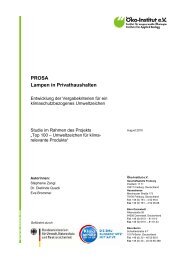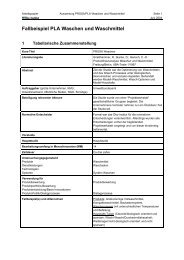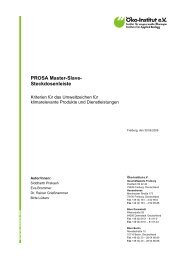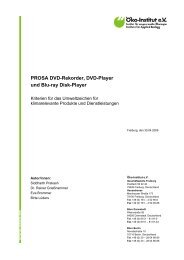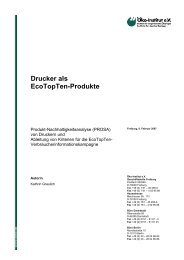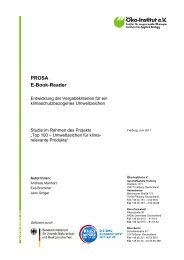PROSA – Product Sustainability Assessment - PROSA - Produkt ...
PROSA – Product Sustainability Assessment - PROSA - Produkt ...
PROSA – Product Sustainability Assessment - PROSA - Produkt ...
Sie wollen auch ein ePaper? Erhöhen Sie die Reichweite Ihrer Titel.
YUMPU macht aus Druck-PDFs automatisch weboptimierte ePaper, die Google liebt.
<strong>PROSA</strong> <strong>Product</strong> <strong>Sustainability</strong> <strong>Assessment</strong><br />
Compared to environmental and economic aspects, social aspects present special<br />
problems 35 , because they can be highly diverse and are weighted very differently by different<br />
interest groups and in different countries and regions. A further point is that evaluations of<br />
these aspects are subject to swifter change over time than those of environmental aspects.<br />
The experience gained in the development of LCA methodology indicates that a coordinated<br />
development of a Social Life Cycle <strong>Assessment</strong> (SLCA) methodology suitable for treating<br />
social aspects will need about five to ten years.<br />
Past experience in product sustainability assessment shows that major product-related social<br />
aspects are largely of three types:<br />
• Particularly severe positive or negative effects (Hot Spots) at the level of resource<br />
extraction, upstream chains, production or trade that can be attributed directly to the<br />
product: Examples are destruction of systems that support human livelihoods, child<br />
labour, wages below subsistence level, etc.<br />
• Utility aspects and impacts upon consumers.<br />
• Indirect effects of product use upon society, such as changes in society caused by cars<br />
or mobile phones (comparable to the discussion on rebound effects in environmental<br />
LCA).<br />
Nonetheless, other incidences can be found even if they are not as obvious as human rights<br />
infringement. However, in a perspective of continuous improvement of the corporation<br />
activities and policies, they are as relevant to study. The overall conditions of production<br />
throughout the chain must be object of assessment including those aspects that represent<br />
added-value such as holiday and paternity leaves.<br />
Many impacts can be assigned to different dimensions, as current indicator list practice<br />
shows. This is exemplified by health-relevant indicators (sometimes assigned to the<br />
environmental dimension, sometimes to the social dimension) or indicators relating to the<br />
workplace and regional economy such as the number of jobs, the strengthening of the<br />
regional economy etc. (sometimes assigned to the economic, sometimes to the social<br />
dimension). This should be object of a decision at the step of defining the indicators.<br />
35<br />
Flysjö stresses the problems of social aspects: "Nor are they (at least to a quite large extent) quantifiable,<br />
why a lot of the “simplicity” of normal LCA is lost. This makes it also difficult to relate to a functional unit"<br />
(comment Anna Flysjö, april 16, 2006)<br />
149



